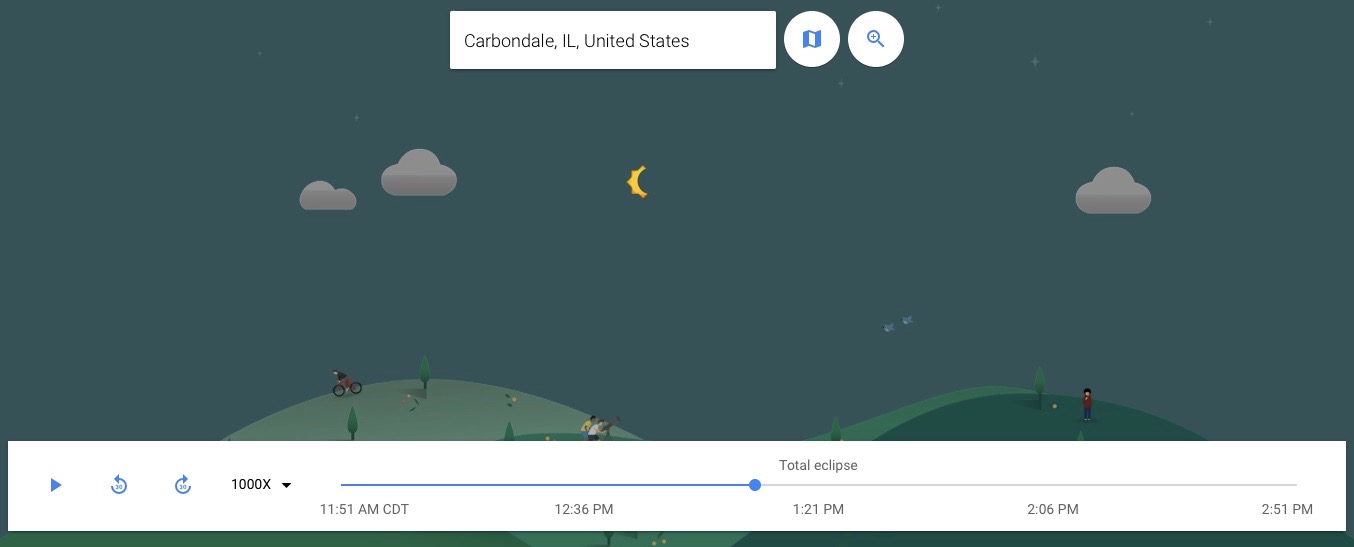Get a Preview of the 2017 Total Solar Eclipse with This Simulator

A new online tool gives eager skywatchers a preview of the Aug. 21 total solar eclipse.
Google and the University of California, Berkeley, have teamed up to create an interactive simulation of the highly anticipated event, which will be the first total solar eclipse visible from the United States mainland since 1979.
You can type your hometown or zip code into the simulator and see how much of the sun will be blotted out by the moon, as well as how the sun will travel across the sky over a 3-hour period on Aug. 21. [The Best Travel Destinations for Seeing the 2017 Total Solar Eclipse]
"There are lots of online animations of the 2017 eclipse, but you can't use them like ours to get a sense of the full experience, including your surroundings," project team member Dan Zevin, of UC Berkeley's Space Sciences Laboratory, said in a statement. "Our simulation is closer to what one might experience in a planetarium show."
The simulator is part of the Eclipse Megamovie Project, a Google-UC Berkeley effort that aims to collect and stitch together thousands of photos of the Aug. 21 eclipse taken by volunteer photographers around the country.
You can learn more about the Eclipse Megamovie Project, and the simulator, here: https://eclipsemega.movie.
During the Aug. 21 eclipse, the moon will completely blot out the sun for observers in 12 states, from Oregon to South Carolina. More than 200 million people live within one day's drive of the "path of totality" — the roughly 70-mile-wide (113 kilometers) strip from which a total eclipse will be visible — according to Space.com skywatching columnist Joe Rao.
Get the Space.com Newsletter
Breaking space news, the latest updates on rocket launches, skywatching events and more!
The rest of North America, along with parts of South America, Europe and Africa, will witness a partial eclipse.
Remember: You can safely observe a total solar eclipse without eye protection, but only during the brief totality phase (which will last less than 3 minutes on Aug. 21, no matter where you happen to be). So be very careful. At all other times — even during the partial-eclipse phase — viewing the sun without special eclipse glasses, No. 14 welder's glass or solar filters (if you're using a telescope) can cause serious and permanent eye damage.
Editor's Note: If you take a great photo of the 2017 solar eclipse or any other celestial sight you'd like to share with us and our news partners for a possible story or image gallery, send images and comments in to managing editor Tariq Malik at spacephotos@space.com.
Follow Mike Wall on Twitter @michaeldwall and Google+. Follow us @Spacedotcom, Facebook or Google+. Originally published on Space.com.
Join our Space Forums to keep talking space on the latest missions, night sky and more! And if you have a news tip, correction or comment, let us know at: community@space.com.

Michael Wall is a Senior Space Writer with Space.com and joined the team in 2010. He primarily covers exoplanets, spaceflight and military space, but has been known to dabble in the space art beat. His book about the search for alien life, "Out There," was published on Nov. 13, 2018. Before becoming a science writer, Michael worked as a herpetologist and wildlife biologist. He has a Ph.D. in evolutionary biology from the University of Sydney, Australia, a bachelor's degree from the University of Arizona, and a graduate certificate in science writing from the University of California, Santa Cruz. To find out what his latest project is, you can follow Michael on Twitter.









